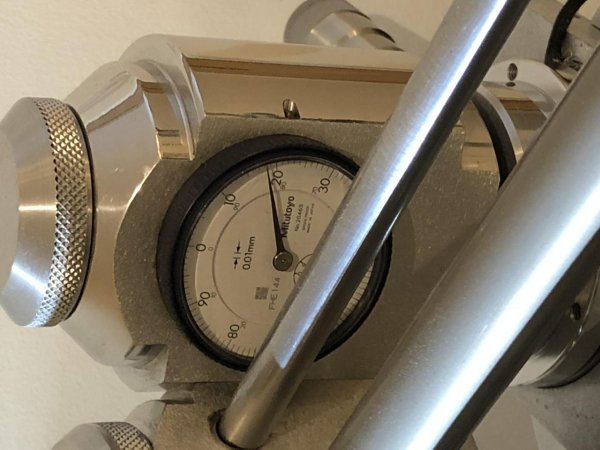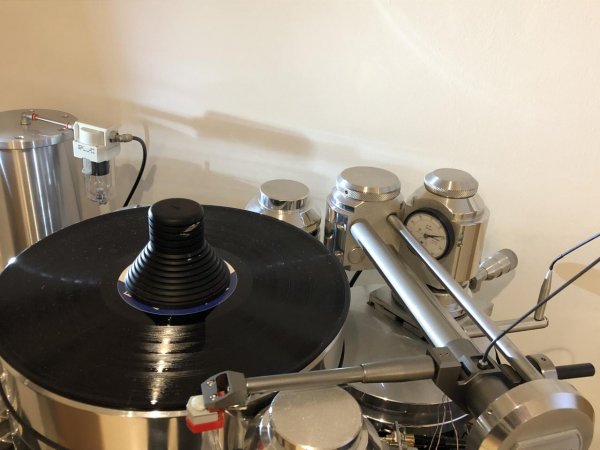Clearly a fundamental disagreement on principle, which is fine
However, I must agree with David on this
I did do it as Peter suggests
Sometimes it worked other times it involved a lot of back and forth
Recently I set my arms up as neutral on a standard record, and note that setting
I can then move up or down dependent
As I have multiple headshells and carts I note which like neutral which tail down etc
Also if different labels what the usual preference is
Thus I can always go back to neutral, and then say oh this is a Melodia probably the best adjustment will be x and go to x
Or I am running this cartridge it likes to be x from neutral, etc
This makes results and fine tuning much easier
My analog system has improved greatly since I made this change in approach
It has allowed me to then move on to clamp tension and support changes and maximise those as well
This is basically what I do too, awsmone. I have a base setting which is my compromise/average height setting for my typical LP, as set up using my protractor and measuring devices and confirmed by listening. In case anyone cares, this is a setting of 17.5mm using my scale on my tonearm. That is the base and it sounds great for about 30% of my LPs.
I use my MINT Protractor to set overhang precisely with the VTF set at 2.0 grams which is the neutral point according to my cartridge manufacturer. The arm is raised to account for the difference in thickness between the MINT glass and the typical LP. I set these parameters - overhang, VTF, VTA, anti skate, zenith, - very precisely with measurements. Then I remove the MINT glass, lower the arm maintaining the same angle because the MINT glass is 1.5mm thicker than a typical 150gram LP. Then I listen. I adjust VTA, VTF anti skate while listening to three reference LPs. I then confirm overhang again. This process is for one particular cartridge. Once I have everything set, this becomes my baseline. And about 30% of my collection sounds great at this setting. I can leave it alone and be done with it. I presume this is what most people do. This is what my dealer did in my system.
I then learned that for other records, very slight adjustments in arm height improve the sound of those particular records. You can say that I am adjusting to "taste" but isn't that what one does with measurements and listening anyway to set his baseline setting? The total range in arm height adjustments I make is 3.0mm which is about a 0.33 degree change in SRA. That covers my entire collection of LPs. I have made very careful measurements about how much overhang and VTF changes with this 1/3 degree of SRA. Some people may not even hear a difference. If that is the case, then so what, my adjustments don't make the sound worse for those listeners. The change in overhang resulting from this 0.33 degree in SRA is not visible to the naked eye, only slightly through magnification with a 10X loupe. The stylus tip moves from the outside of the hair width line inscribed on the MINT arc protractor to the inside of the line, but there is never a visible gap between the line and the stylus tip. I would argue it is not audible. The VTF is so tiny that even David said it was not audible, something like 0.06 gram throughout the entire range. I posted the measurement data up thread.
Last night I listened to Bach's cello suites. All six sides. I never touched the arm height once, so Tang need not worry about the "steps taken during my listening session." I got up from my sofa every 20 minutes or so to flip the records and perhaps clean the stylus after a couple sides. Other evenings I listen to a batch of LPs with perhaps one or two different arm height listings, so I spend perhaps three minutes total resetting the arm.
No black magic here Ron. No voodoo. You can have David set up your rig once and never touch it again, and be happy I'm sure. Tang, on the other hand, is altering David's set up and is enjoying his fine tuning. He actually posted that he improved on David's set up and added a smiley facey thingy for good measure. EDIT: see here:
"When I lowered the tracking force of AtlasSL, I had to readjust the vta to be rewarded with even better sound than when David set up for me....hehe (smiley face)"
Whether it makes a difference or not is up to the listener. I get that people don't want to go to the trouble. David just wrote that a 0.5mm change in arm height can make a significant difference or something like that. EDIT: from David:
"Setting the VTA/SRA correctly has significant impact on the sound specially when dealing with multiple arms & cartridges. One reason that you don't hear people talking about it is that they're struggling with it, it's not trivial +/- 0.5mm can be crucial." That is 1/20th a degree in SRA for a 12" arm. I agree with him. He can hear that when setting up the cartridge. So can I. We know that there is variance of at least 1/20th of a degree with cutting head angles. They varied between 91-94 degrees according to some accounts I have read. Fremer wrote that his 92 degrees is the best compromise setting which would cover most records in people's collections. Records vary in thickness my at least 1mm. All of this means that parameters change when playing different LPs. Some people just choose not to account for those differences by making subsequent adjustments once the original set up is complete. That is fine.
To answer Ron's question, "What say you, Peter?", I suppose I am "tweaking to taste" based on what I hear from variances in the physical characteristics of different records. Everyone who listens during cartridge set up is "tweaking to taste". Otherwise, they would just use the protractor, the weight scale, set the arm level, and be done. No, rather they continue to fine tune arm height adjusting SRA, VTF, and anti skate by ear for the preferred sound. Everyone has his own methods or relies on experts like David to do the work for them. My own SME dealer/ set up guy kept asking me, what do you think, when he was adjusting the arm height during his set up procedure. With my lack of experience at the time, I told him to just set it up and I would learn from him. Can we now end the hearing, so I can go back to work and listening to records?
EDIT: I would like to add one more point in response to David's question about "a starting point". When initially setting up a cartridge in my tonearm, I start with alignment according to my MINT protractor. This was custom made for my specific cartridge and tonearm based on precise dimensions. This arc protractor relies on a very precise stylus to pivot distance, so I first set my arm to be perfectly level with VTF set at the cartridge manufacturer's specified "center" point. For my cartridge it is 2.0g. A tonearm's pivot point is fixed in the horizontal plane, but it moves in the vertical plane when the arm height is adjusted. Therefore, I want the shortest distance between the pivot point (in 3 dimensions) and the stylus point for the most accurate pivot to stylus distance. This is effective length and the arm must be level for this dimension to be accurate. This is what the MINT arc protractor is based on.
So to answer David's question as precisely as I can, the starting point for my arm, prior to any listening, is a very precise position based on five things: anti skate set to zero, a very accurate pivot to stylus distance based on effective length, the center point (VTF) for the given cartridge coils and magnets based on manufacturer's specifications, and a perfectly level tonearm relative to the position of the stylus as it rests on the given glass thickness of my MINT protractor. Finally, I adjust zenith angle by rotating the cartridge slightly in the headshell until the cantilever and parallel lines at the null points inscribed on the MINT protractor line up. These steps together assure accurate alignment. That is my starting point and based on the tonearm being level.
Having established this alignment, I then adjust arm height down by a distance equal to the difference between the thickness of the glass protractor and the thickness of a typical/average record (150g) in my collection. I think this is 1.5mm, but I would have to check my notes. Now I place this reference LP on the table and listen. Remember, the arm is still level at this point. I then make very fine adjustments by ear to arm height (SRA/VTA), VTF, and antiskate. I did reconfirm overhang and alignment a couple of times after months of listening and adjusting arm height and according to the MINT arc protractor, it was still spot on.
After these minor adjustments by ear, I reach a setting which I call my "reference setting" which is the preferred set up for a typical record in my collection. The arm height at this reference setting is 17.5mm according to the scale that I have devised by measuring between the arm board and bottom of the arm locking mechanism. The various settings that I have found sound good for my collection range between 16mm and 19mm. That is only 1.5mm up or down from this reference setting of 17.5mm. 1.5mm represents a change in SRA of only 3/10th of one degree. These differences are clearly audible. David says 0.5mm in arm height "can be crucial". I agree, and that is why I make the adjustments.
I hope this answers the question about a "starting point".



